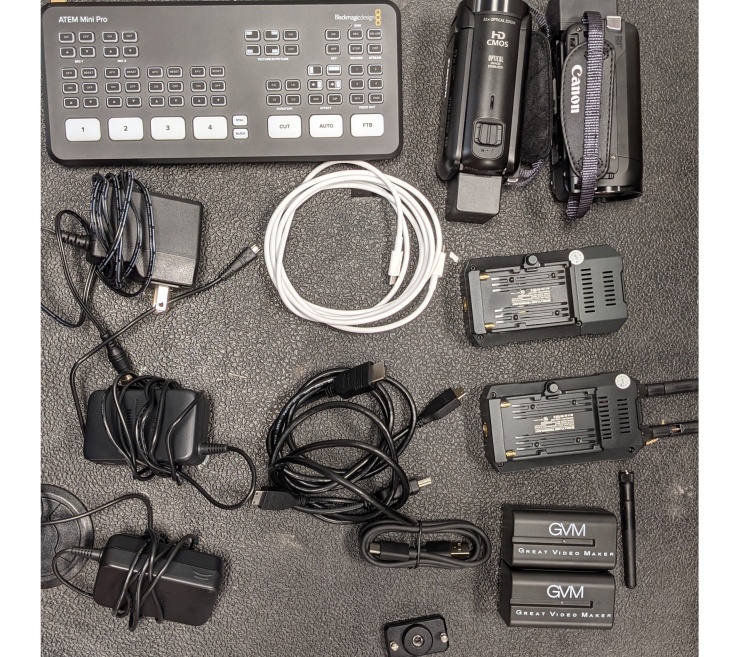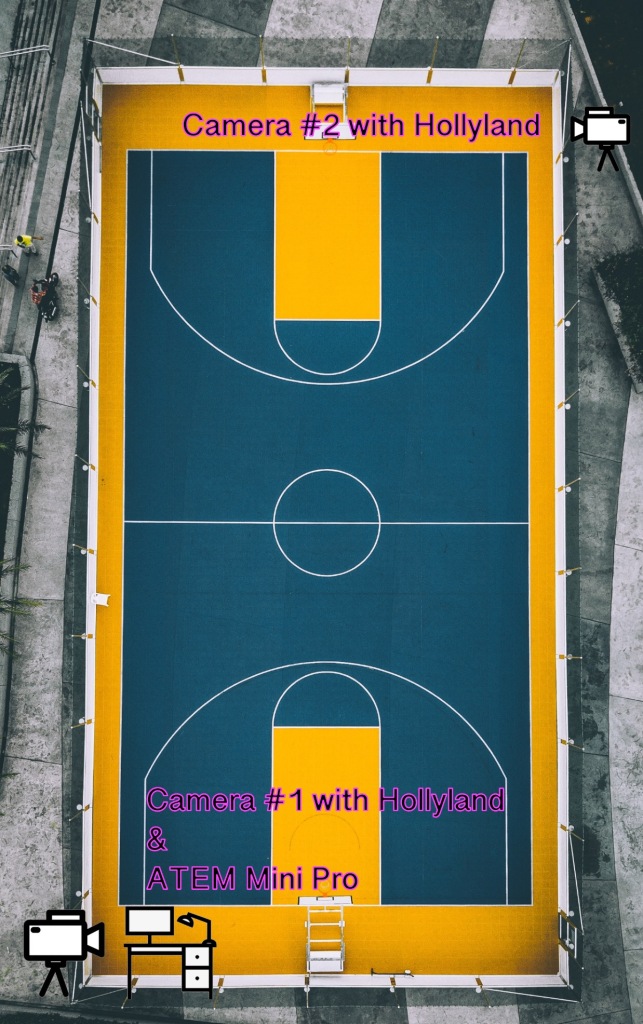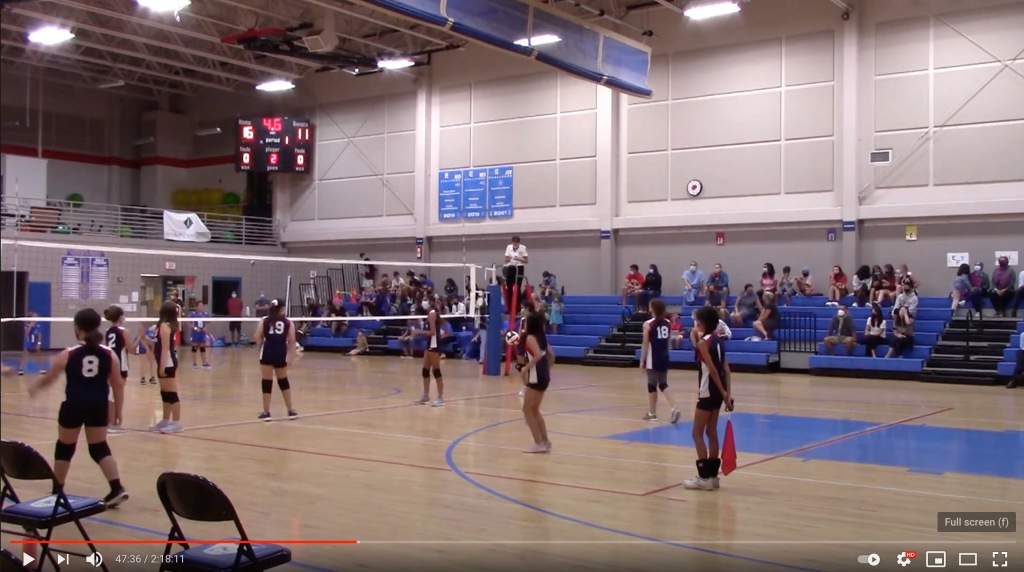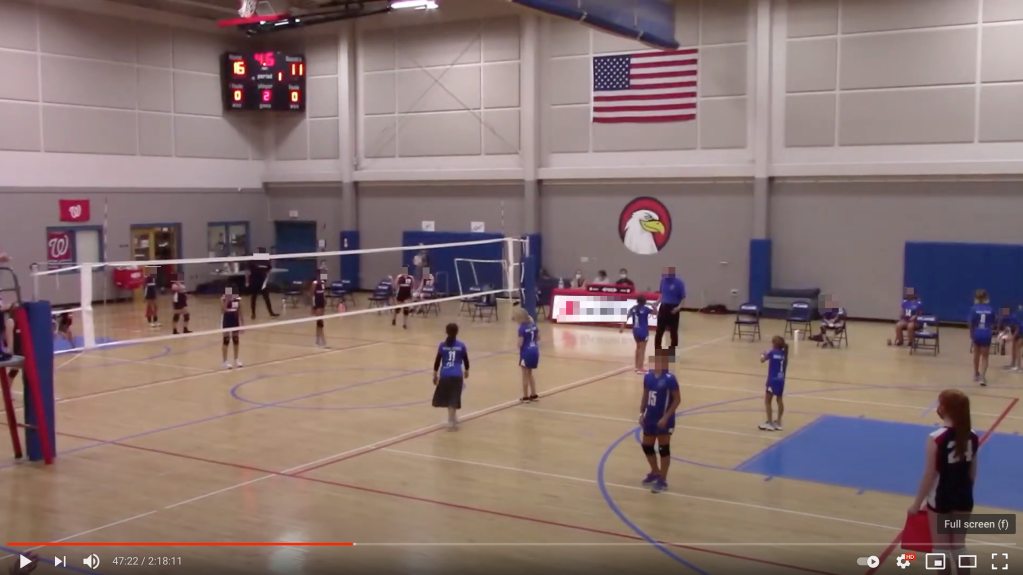Streaming Events #3 – Test!

Well…we tested and….it went well!
We streamed two middle school volleyball matches. The total stream lasted about 2.5 hours and we streamed it on a lonely YouTube account. That way if there were mistakes they would be seen by very few people (in fact the only people who tuned in were people in the gym 
Not everything we great, but nothing was terrible which is good. Middle school students did most of the setup and the actual streaming. Overall, it was pretty good.
Setup
Like I said students did most of the setup. Here is the list of supplies that were used.
- Table (for streaming setup)
- Monitor
- Laptop with BlackMagic software to setup the stream
- Two tripods
- Two Canon Vixia HF R800 video cameras
- ATEM Mini Pro
- Two Hollyland Mars 300 transmitter and receiver
- Ethernet cable to connect the ATEM Mini to our network
- HDMI cables to connect monitor, video camera and one Hollyland receiver to the ATEM Mini Pro
- Power strip for monitor & ATEM Mini Pro
That’s about it. We started to set up at 3:40 and were completely connected by 4:05. The first match started at 4:30 so we had some time to test out some things.
Here is where we set everything up.

We tried setting up the camera in the middle of the court on the bleachers, but since our cameras are not wideangle and our bleachers are pretty close, it only captured about 60% of the court which isn’t doable.
So we decided to try and capture from the far corners of the gym. Camera #2 was up on the bleachers and had a pretty good vantage point. It covered almost all of its side. Camera #1 was plugged into ATEM Mini with a pretty short HDMI cable so it was pretty restricted of where we could set it up and how high or far it could be from the desk.
Here is a shot from Camera #1

Not bad, but during the second match the coach was standing up and the line judge was an adult. The two unwittingly made a decent wall and blocked good portions of the court from this camera. Also, the table we had was just a plastic table and when we rested our sat a water bottle (for example) the image on the camera shook. Not great.
Here is a shot of Camera #2

As you can see the serving area for the blue team is a little cut off. We tried a few things during the stream and most did not work. We tried zooming in and following the action. Not a good idea. It was jerky, disorienting as you got lost with the camera movements and a touch of motion sickness.
If you noticed that this image is not as clear as from camera #1 you would be correct. We suspect that it is because it is wirelessly transmitting the image to the ATEM Mini Pro as opposed to being directly connected. Another option could be the distance from the court and that movement on the bleachers did shake the camera and the image.
Sound
For nearly the entire match we turned the sound off. We did this for a couple of reasons. One, we didn’t know if the school was going to pipe in music during timeouts and between games. If you’re not too aware, that is a quick way of getting your live stream taken down or at the very least muted. They have algorithms that “listen” for copyrighted music and then take automated action.
The other reason is that we were talking. It was our first time, so we were testing out the equipment, making adjustments on the fly and discussing how they improved or hurt the stream. Of course we were also just chatting away about the match, technology and all sorts of other issues and being so close to the camera meant that it would definitely pick us up.
In the future we would like to have the sound of the game being captured. It makes it a lot more exciting. Maybe that means we leave some cameras to be unmanned or to move it well clear of the ATEM Mini Pro and the people producing the live stream.
Battery life
This was a pleasant surprise. We had batteries on each video camera. We turned them on a little after 4:00pm and they barely lasted until 6:35pm. Not too bad at all. The Hollyland Mars 300 also used batteries for the transmitter and receiver but we could not find a battery indicator on the packs. Reviews online said they should last between 4-5 hours which would be more than what we would ever need.
What worked and what we need to work on
Basically less is more. We learned that setting up the camera and moving it as little as possible was the way to go. Also, we needed some backup batteries. The second match of the night lasted all three games but the first match was a pretty quick one were one team easily one over the other. If both were a little longer the stream would have to have ended early. That’s not great.
The good news is that finding generic batteries with chargers is pretty easy and they are pretty reasonably priced as well.
Longer HDMI cables are needed to we have a little more flexibility setting up Camera #1. We need to get it higher than what it was and move it further away from the ATEM Mini. Those cables aren’t terribly expensive ($10-$15 on Amazon) so that won’t be a problem.
We simply need more experience. We had three students cycle through manning Camera #2, working the ATEM Mini Pro and just being a free person to cover anything if someone had to go to the restroom or get some food. It worked for the most part, but sometimes people would get too excited about switching between the two cameras and it gets a bit jarring. Other times, we wouldn’t be paying attention and it looks like no one is manning anything.
Then there were the different cuts and wipes. The ATEM Mini Pro will let you switch between cameras using a hard cut or a transition (usually a wipe or fade). The buttons between the two are clearly marked but sometimes the kids would hit the wrong one and instead of a cut to the action from camera #2 we would get a slower wipe and the play may be over by that time. It’ll take practice.
Overall
It was good! Students set up and tore down. They also did the bulk of the streaming and they did an OK job for the first time. Lots more to learn and improve upon, but I was wondering if it would be feasible to turn this project over to students in the future. There would still need to be adult supervision but in the long run, I think it is very feasible and if you had older high school students at your school doing it I think it would work very nicely.
Ideas
We are thinking of adding another camera and also running the ATEM Mini Pro through OBS Studio. Of course those are projects for another day. Right now we are pretty happy with how the first stream turned out. Check it out below.
Source: IT Babble Blog and Podcast
You must be logged in to post a comment.